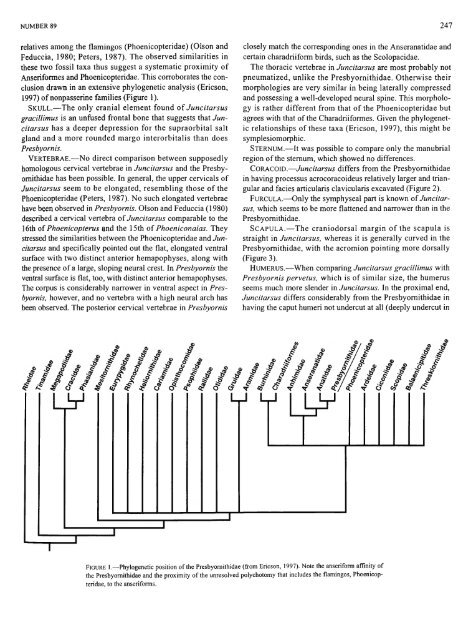PDF (Lo-Res) - Smithsonian Institution Libraries
PDF (Lo-Res) - Smithsonian Institution Libraries
PDF (Lo-Res) - Smithsonian Institution Libraries
Create successful ePaper yourself
Turn your PDF publications into a flip-book with our unique Google optimized e-Paper software.
NUMBER 89 247<br />
relatives among the flamingos (Phoenicopteridae) (Olson and<br />
Feduccia, 1980; Peters, 1987). The observed similarities in<br />
these two fossil taxa thus suggest a systematic proximity of<br />
Anseriformes and Phoenicopteridae. This corroborates the conclusion<br />
drawn in an extensive phylogenetic analysis (Ericson,<br />
1997) of nonpasserine families (Figure 1).<br />
SKULL.—The only cranial element found of Juncitarsus<br />
gracillimus is an unfused frontal bone that suggests that Juncitarsus<br />
has a deeper depression for the supraorbital salt<br />
gland and a more rounded margo interorbitalis than does<br />
Presbyornis.<br />
VERTEBRAE.—No direct comparison between supposedly<br />
homologous cervical vertebrae in Juncitarsus and the Presbyornithidae<br />
has been possible. In general, the upper cervicals of<br />
Juncitarsus seem to be elongated, resembling those of the<br />
Phoenicopteridae (Peters, 1987). No such elongated vertebrae<br />
have been observed in Presbyornis. Olson and Feduccia (1980)<br />
described a cervical vertebra of Juncitarsus comparable to the<br />
16th of Phoenicopterus and the 15th of Phoeniconaias. They<br />
stressed the similarities between the Phoenicopteridae and Juncitarsus<br />
and specifically pointed out the flat, elongated ventral<br />
surface with two distinct anterior hemapophyses, along with<br />
the presence of a large, sloping neural crest. In Presbyornis the<br />
ventral surface is flat, too, with distinct anterior hemapophyses.<br />
The corpus is considerably narrower in ventral aspect in Presbyornis,<br />
however, and no vertebra with a high neural arch has<br />
been observed. The posterior cervical vertebrae in Presbyornis<br />
closely match the corresponding ones in the Anseranatidae and<br />
certain charadriiform birds, such as the Scolopacidae.<br />
The thoracic vertebrae in Juncitarsus are most probably not<br />
pneumatized, unlike the Presbyornithidae. Otherwise their<br />
morphologies are very similar in being laterally compressed<br />
and possessing a well-developed neural spine. This morphology<br />
is rather different from that of the Phoenicopteridae but<br />
agrees with that of the Charadriiformes. Given the phylogenetic<br />
relationships of these taxa (Ericson, 1997), this might be<br />
symplesiomorphic.<br />
STERNUM.—It was possible to compare only the manubrial<br />
region of the sternum, which showed no differences.<br />
CORACOID.—Juncitarsus differs from the Presbyornithidae<br />
in having processus acrocoracoideus relatively larger and triangular<br />
and facies articularis clavicularis excavated (Figure 2).<br />
FURCULA.—Only the symphyseal part is known of Juncitarsus,<br />
which seems to be more flattened and narrower than in the<br />
Presbyornithidae.<br />
SCAPULA.—The craniodorsal margin of the scapula is<br />
straight in Juncitarsus, whereas it is generally curved in the<br />
Presbyornithidae, with the acromion pointing more dorsally<br />
(Figure 3).<br />
HUMERUS.—When comparing Juncitarsus gracillimus with<br />
Presbyornis pervetus, which is of similar size, the humerus<br />
seems much more slender in Juncitarsus. In the proximal end,<br />
Juncitarsus differs considerably from the Presbyornithidae in<br />
having the caput humeri not undercut at all (deeply undercut in<br />
FIGURE I.—Phylogenetic position of the Presbyornithidae (from Ericson, 1997). Note the anseriform affinity of<br />
the Presbyornithidae and the proximity of the unresolved polychotomy that includes the flamingos, Phoenicopteridae,<br />
to the anseriforms.

















